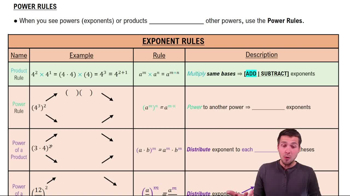9. If the Trapezoid Rule is used on the interval [-1, 9] with n = 5 subintervals, at what x-coordinates is the integrand evaluated?
Table of contents
- 0. Functions7h 54m
- Introduction to Functions16m
- Piecewise Functions10m
- Properties of Functions9m
- Common Functions1h 8m
- Transformations5m
- Combining Functions27m
- Exponent rules32m
- Exponential Functions28m
- Logarithmic Functions24m
- Properties of Logarithms36m
- Exponential & Logarithmic Equations35m
- Introduction to Trigonometric Functions38m
- Graphs of Trigonometric Functions44m
- Trigonometric Identities47m
- Inverse Trigonometric Functions48m
- 1. Limits and Continuity2h 2m
- 2. Intro to Derivatives1h 33m
- 3. Techniques of Differentiation3h 18m
- 4. Applications of Derivatives2h 38m
- 5. Graphical Applications of Derivatives6h 2m
- 6. Derivatives of Inverse, Exponential, & Logarithmic Functions2h 37m
- 7. Antiderivatives & Indefinite Integrals1h 26m
- 8. Definite Integrals4h 44m
- 9. Graphical Applications of Integrals2h 27m
- 10. Physics Applications of Integrals 3h 16m
- 11. Integrals of Inverse, Exponential, & Logarithmic Functions2h 34m
- 12. Techniques of Integration7h 41m
- 13. Intro to Differential Equations2h 55m
- 14. Sequences & Series5h 36m
- 15. Power Series2h 19m
- 16. Parametric Equations & Polar Coordinates7h 58m
8. Definite Integrals
Riemann Sums
Problem 8.8.24
Textbook Question
23-26. {Use of Tech} Simpson's Rule approximations. Find the indicated Simpson's Rule approximations to the following integrals.
24. ∫(4 to 8) √x dx using n = 4 and n = 8 subintervals
 Verified step by step guidance
Verified step by step guidance1
Step 1: Understand Simpson's Rule. Simpson's Rule is a numerical method to approximate the value of a definite integral. It uses parabolic arcs to approximate the curve of the function. The formula is: , where h is the width of each subinterval, and n is the number of subintervals (must be even).
Step 2: Determine the interval and subinterval width. The integral is over the interval [4, 8]. For n = 4 subintervals, calculate the width of each subinterval as . For n = 8 subintervals, calculate .
Step 3: Identify the x-values. For n = 4, the x-values are . For n = 8, the x-values are .
Step 4: Evaluate the function at each x-value. The function is . Compute for both n = 4 and n = 8 subintervals.
Step 5: Apply Simpson's Rule formula. Substitute the values of , into the Simpson's Rule formula for both n = 4 and n = 8 subintervals. Simplify the expression to approximate the integral.
 Verified video answer for a similar problem:
Verified video answer for a similar problem:This video solution was recommended by our tutors as helpful for the problem above
Video duration:
5mPlay a video:
Was this helpful?
Key Concepts
Here are the essential concepts you must grasp in order to answer the question correctly.
Simpson's Rule
Simpson's Rule is a numerical method for approximating the definite integral of a function. It uses parabolic segments to estimate the area under a curve, providing a more accurate approximation than methods like the trapezoidal rule. The formula involves evaluating the function at equally spaced intervals and applying weights to these values, typically using three points for each segment.
Recommended video:
Guided course

Power Rules
Definite Integral
A definite integral represents the signed area under a curve defined by a function over a specific interval [a, b]. It is calculated using the Fundamental Theorem of Calculus, which connects differentiation and integration. The result of a definite integral is a number that quantifies the total accumulation of the function's values across the interval.
Recommended video:

Definition of the Definite Integral
Subintervals
Subintervals are smaller segments into which the interval of integration is divided when applying numerical methods like Simpson's Rule. The number of subintervals, denoted as 'n', affects the accuracy of the approximation; more subintervals generally lead to a better approximation of the integral. Each subinterval's width is determined by dividing the total interval length by 'n'.
Recommended video:

Introduction to Riemann Sums
Related Videos
Related Practice
Textbook Question
13
views


